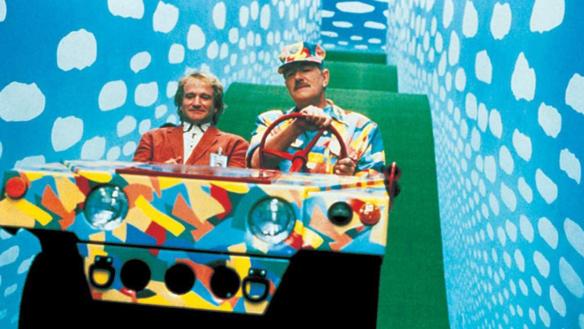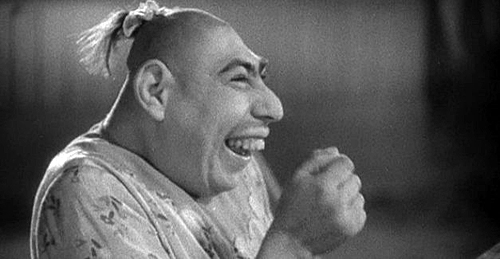
Nighty night.
Jiří Barta is renowned as a master of stop-motion animation. He is hailed alongside fellow Czech animator, Jan Švankmajer. He has also had a dickens of a time getting a new movie made, but he has finally done it. Jiří Barta’s latest creation, the feature film In the Attic: Who Has a Birthday Today? (2009) (aka Na půdě aneb Kdo má dneska narozeniny?) [update: recently released on DVD in the US with English dubbing under the title Toys in the Attic], is a wonderfully imaginative fairytale adventure. I was blessed enough to see it for the LA premiere at the Silent Movie Theater for their animation festival.

Scenes from Golem.
Some of the most innovative animators in the world seem to be coming from Russia, Czechoslovakia, and Eastern Europe. Names like Yuriy Norshteyn (Tale of Tales), Alexander Petrov (The Mermaid), Karel Zeman (The Fabulous World of Jules Verne), Ivan Maximov (From Left to Right), Jiří Trnka (The Cybernetic Grandma), George Pal (Tubby the Tuba and Puppetoons), Jan Balej (One Night in One City), Ivan Ivanov-Vano (The Battle of Kerhzenets), Jan Švankmajer (Dimensions of Dialogue), Władysław Starevich (The Mascot), and Barta are all names to look out for. If any of these names are mere foreign words to you, then you definitely need to check out some of their brilliant work.

Stop-motion rat corpses. Seriously.
In the Attic represents Jiří Barta’s return to stop-motion animation after several years of trying to get his failed Golem project off the ground (and the small amount of footage he did produce for Golem is nothing short of staggering). Barta has achieved much recognition for his enchanting short animated films (many of which can be seen in the excellent Barta DVD compilation Labyrinth of Darkness), but has completed only one previous feature–length movie, The Pied Piper of Hamelin (1985). Unlike the dark, gnarled near-nightmarescape of Pied Piper, however, In the Attic is a far gentler film and made to be appreciated by children.
Check out Pied Piper, it is also quite good.
Barta’s newest movie is a richly textured, quiet, and tranquil story punctuated by some fun action and brilliant cinematic innovation and magic. At heart In the Attic: Who Has a Birthday Today? is a light rescue movie filled with fun characters, exciting peril, cross-country journeys, and wild vehicles. It is the story of old toys in an attic and although the subject matter might remind you of Pixar’s Toy Story, the dazzling inventions will hearken back to Nick Park’s Wallace and Gromit adventures, while the style remains more reminiscent of the opening of The Many Adventures of Winnie the Pooh and some things dreamed up by the Brothers Quay or Švankmajer. In the Attic might remind you of all of these things, but it is all Jiří Barta.

Choo choo.
The story is simple and sublime and despite being geared at children it does have some potent anti-communist political themes. It takes place, quite aptly, in an attic—the rest of the title comes from the recurring gimmick of the characters rolling the dice every morning to decide whose birthday they will celebrate that day. Buttercup is a sweet little doll who lives in an old trunk in the attic along with her friends; the sleep-loving Teddy, a tattered stuffed bear; the quixotic Sir Handsome, a battered and delusional marionette; and the feisty Schupert, a ball of clay with a pencil nose. She cooks and cleans for them and the boys go off to work on the railroad or fight inflatable alligators and all is idyllic tranquility (so women’s lib). Indeed, I was beaming with delight and my smile could not be suppressed by the sheer cuteness of the whole spectacle.

Buttercup.
Naturally, conflict must enter in on the scene and disturb the quaintness of it all (unless you happen to be Hayao Miyazaki, who doesn’t seem to require villains to tell a great story). A mechanical tube with a human-like eyeball spies the peaceful lives of the attic denizens, reporting back to its master via an old television set that is obsessively monitored by a ruthless, old, cigar-chomping, golden bust with Hunter S. Thompson shades and an entourage of bugs and mismatched bits of rubbish. The tarnished voyeur spies Buttercup in her tatterdemalion serenity and concludes that he must have her for himself. Perhaps he thought of it himself or perhaps the nasty earwig with spectacles and a Dalí mustache who whispers wicked things into the head’s ear put the idea in his brain.

The puppet master?
The evil golden head deploys hordes of beetles to terrorize poor Buttercup and hires a house cat to don clothing and trick the doll girl into stumbling into his bent corner of the attic. Once inside the land of evil, Buttercup is placed under arrest until she agrees to wed the head. She is forced to clean out the furnace all day and all night while the head’s cronies only dump more soot and ash on top of her whenever she gets done. Buttercup remains defiant to all of the head’s advances.

The dark part of the attic (a la postwar East Germany).
Back on the other end of the attic, Sir Handsome and Teddy discover their beloved Buttercup is missing. Together they start on a quest to bring her back from the land of evil. A brave lady mouse—who runs the attic radio—tinkers together to construct a flying machine out of an old vacuum cleaner and other discarded junk. She and a plump piglet toy band together with all of the other little toys and scraps (mostly wooden chess pieces) and fly out to meet Teddy and Sir Handsome who are already well on their way.
Pillows bloom and rise out of old dressers and steadily rise only to link together and snow on them like big, fluffy clouds. The cat opens up a wardrobe unleashing an inundation of blue sheets, cloaks, and fabrics to represent a terrible flood for the traversing toys. Most of the perils are truly imaginative and, yes, adorable.

What fun.
At last our heroes meet up together, but then are plagued by more moth-eaten horrors sent by the golden head in the land of evil. The golden head has spies everywhere and will not tolerate simple toys trespassing on his side of the attic, nor will he risk Buttercup’s emancipation before he can brainwash her and make her his. Don’t worry. Things get hairy, but it all works out in the end and Barta has more animation tricks up his sleeve to share before this delightful excursion comes to a pleasing finale.

The Head.
Jiří Barta’s In the Attic: Who Has a Birthday Today? is a beautiful film with much to love and to look at. It is sweet and charming and full of imagination and quirky gimmicks—like Teddy’s vanity when he shines his nose and brushes his teeth incessantly or Schubert’s battle to stay in one piece during a rainstorm on the roof—and the entire family is sure to enjoy it. I do admit that I love the Toy Story movies, but there is a big difference between these films and much of it has to do with the animation style. The slick and beautiful computer generated world of Toy Story is colorful and complex and it reminds me of certain toys I had growing up, but In the Attic is rich like a quilt made by your great-great grandmother. The characters of In the Attic feel like toys that always were. Where Toy Story’s characters are more like adults who understand the preciousness of the love of a child and depend on it yet banter and reason like grownups, In the Attic’s characters are independent and have the personalities and subtleties that only a child would give them during playtime. In addition to actually being three-dimensional they behave as I would imagine toys would behave had they lives outside of a child’s imagination.

Teddy brushing his teeth.
All in all In the Attic: Who Has a Birthday Today? is a rare treat. It’s a completely innocent child’s fairytale full of adventure and friendship. It’s rich in nostalgia and imagination and it’s really cute. As I sat in the theater and let the simple, dully colored, tattered figures do their dance, I wanted to believe in this attic universe. It felt like how I always imagined my grandfather’s basement to be when I was a kid. His basement was full of old gadgets, toys, objects, pictures, and furniture and I always suspected that whenever I turned off the lights that it had a mind of it own.

Schupert.
Although still not available on home video, I have since emailed the production company of this film and they have responded with hints of an English dub for re-release for British and American theaters and possibly a subsequent DVD/bluray release. Let us hope that we may soon obtain copies and curl up under an old blanket by the fire and watch it with our families. [Update: yeah, scratch all that. It’s out now].
Top 1o Reasons to See In the Attic: Who Has a Birthday Today?
1. It’s an adorable movie the whole family can enjoy.
2. It marks a legendary animator’s return to his craft.
3. They travel by land, air, and sea on their quest.
4. The mechanisms and social structure designed by the characters in the film are really clever and fun to watch.
5. It has deeper political themes instead of tired pop-culture references for the adults in the audience.
6. Jiří Barta fashions an entire world with its own rules and it is a pleasure to admire.
7. It’s got it all: damsels in distress, heroes, villains, monsters, adventure, inventions, and comedy.
8. If Švankmajer’s Alice was too dark or weird for you then this is a good alternative.
9. Teddy’s cheeks when he smiles are so freaking cute!
10. There is a weird thing with a pocket watch toward the end that is amazingly cool.
Originally published for “The Alternative Chronicle” Dec. 13, 2010



































































